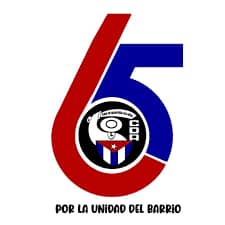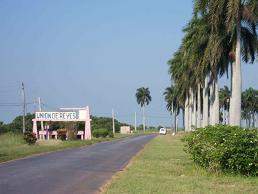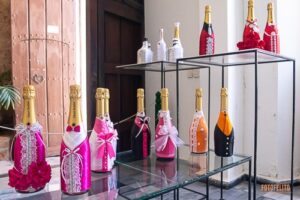The sugar cane mill of my memories.
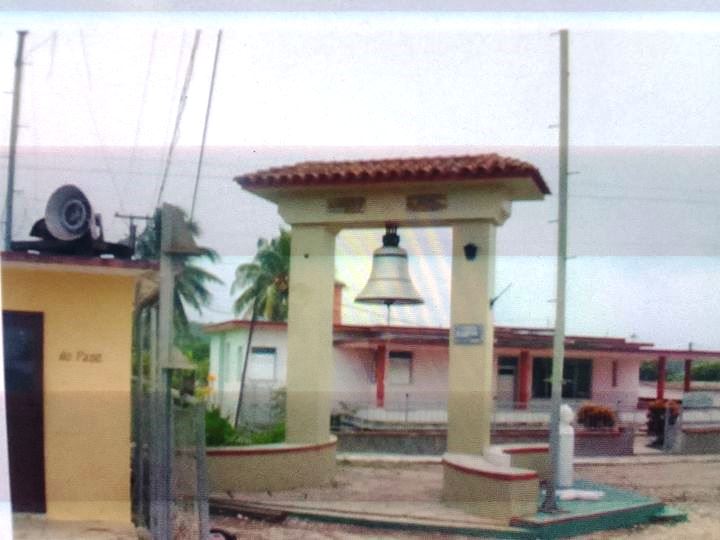
Exif_JPEG_420
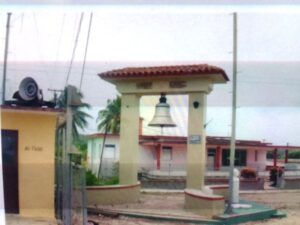
The tower is alone and the old man observes it. The tower is lost in the sky and the old man watches it. He waits to see the smoke, dark or blue.
He waits, but it doesn’t happen and he sleeps.
It has always been like that, since that fateful day: the silent plant, with no bell or whistle to call to work, to make some leave home and others return, after each shift. A central without the noise of the machines, without the smell of sugar or the unbearable cachaza.
I wrote something like that in Adiós, a theatrical drama about the disappearance of the sugar mill that I have loved most in my life, one of the oldest in Cuba, with its bell intact, beautiful, witness of history in the middle of the courtyard, near the Roman and the huge machines, of the house of the owner, Adolfo Marzol, which later was my elementary school.
In Adiós there is a locomotive, but in my sugar mill I never saw it pass by, loaded with sugar cane or sacks of sugar, although there were once, because the line was behind my house, with an intact railway signaling, in front of the cane field, which is not today either, the refuge of my childhood, my Sherwood Forest.
There were no locomotives, but there were ox carts and tractors and trucks. Each era had paradigmatic names for those who did this work. In mine, I especially remember Zenén, who was the nicest of the tractor drivers and would let us take canes from his wagon. He was the one who loaded it the most, the champion of the tractor drivers, the hero of the children. They all left traces on the roadside and the road.
A favorite game was to pick them up, pile them up in the yard, chop them into small pieces and with our hands, load improvised carts, to become men of the cane fields. Or to make guarapo in a trapiche made of line nails, with a zinc channel. Or to throw it to the pigs, who demolish it with their teeth and only leave the bagasse, as a human central.
I remember the edge of the roads that go from Cárdenas to Limonar and the reeds, near the ditches, like a long, meandering carpet. Sometimes there were brigades to pick them up. Other times, they stayed there forever. The efficiency of those who loaded them was in never leaving them abandoned; but that depended on the skill of the drivers.
My ingenio was called La Julia and later Triunfo and with the Revolution: Comandante Horacio Rodríguez, whose bust is in the center of the central, in the little park.
Every January 2nd, events were held to remember the death of the union leader, of the Granma expeditionary, of the member of the Rebel Army who died in combat one day after the triumph of the Revolution.
That was the ingenuity that I knew from the vision of a child, who also knew many of the workers of the plant. The other memories, which have nothing to do with this one, are part of the memory of my ancestors, who lived from it.
It was the only sugar mill that remained of the nine that existed in the Guamacaro Valley in the 19th century. One of the most productive in the area in the first half of the century, as was the legendary La Perla, where Maceo camped when it had been demolished three years before.
The place where a combat took place that made Maceo, after fighting and fleeing, reach La Julia among reed beds and maniguas to set fire to it, which was his way of stopping the Spaniards. The old men say that the women cried and the General did not destroy it. That is what they say. That is why they called it Triunfo. That is why.
I know there is another story, but this is the one I like.
The history of the sugar mills of the Guamacaro Valley is that of demolition. Of some, only a few stones remain, like San Laureano. Of others, the ruins, with their tree-infested barracks, like Las Morlas. Perhaps they are one of the few barracks that persist.
Of La Perla, there are only some foundations and the tombstone that commemorates the combat. Of Dolores Junco, some foundations and the fornellas, that hole where the ashes of the furnaces used to end up. The others (Las Marías, Santa Lucía, Botino) do not exist, just that. Or we have not looked for them.
A friend of mine -Ofrey Hernández- who has dedicated himself to retracing the Guamacaro Valley, has found traces of most of them, the foundations or fornellas, a ceiba tree where the slaves say they left their footprints, a fragment of a barracks, an iron cauldron.
But most of the ingenios cannot be remembered even by my grandfather Nicolás Febles, who was a good storyteller. Only the land and the memory. But memories go with the dead. And memories are more than figures and statistics. Those help to recall a part of those memories. The other, the one that doesn’t appear in the books, in the news, is in people’s memories, in the abyss.
My wit must have seen Maceo and his mambises fight. It must have seen the black slaves and the wagons and their carters, where my uncles and my ancestors earned their livelihood in the central or in the harvest.
She must have seen their owners, their good or arrogant acts. The beautiful eyes of Mercedes, wife of the first owner.
The power plant must have been a wrecking machine; but necessary for a country and for the area. The most important thing for subsistence, the only thing its people knew how to do, besides harvesting the land, including sugarcane; a reason to be proud of, what made life exist: the mill grinding or preparing to grind, the incessant traffic, the people who work and live from it, the women washing clothes and preventing the soot from soiling them… That is why they remember it with nostalgia.
And nostalgia, the old man of Goodbye can’t write it, he carries it inside and also the pain. He can’t write it, but he sits and watches how everything remains in an eternal «dead time».
I ask him: What’s wrong with you? And he tells me how he arrived one day to the central, how he learned all the trades, how he knows every piece, every corner, every sound.
And he tells me: And I quote: (1)
«The sugar weighers in coordination with the floor manager were the ones in charge of the administration to watch over the loading of sugar onto the trucks (at that time it was in 325-pound sacks) to any destination, which could be to the docks for export or to the warehouses that some businessmen had for distribution to the warehouses of the population.
«The quality of the sugar depended on the agreed price and the place of consumption. Because of this there was always a working relationship between the rural guards and the weighers, to such an extent that in this weighing there were two old stools in the Romana folder, one for the weigher and the other for the guard.
«The sugar weighers made up invoices on models that had carbon paper so that two copies would come out. These had to be made in ink pencil and had to show the destination, the number of sacks, the weight and the signatures of the weigher and the guard on duty.
«The work shifts in the sugar mills were from 11:00 am to 7:00 pm, from 7:00 pm to 3:00 am and from 3:00 am to 11:00 am, and the workers had to be relieved half an hour before each shift, in order to have time for the delivery of the work station. The sugar mills were equipped with huge whistles, which worked with steam. The whistle was blown at half past one o’clock before entry and at one o’clock on the dot so that everyone would be at their post.
«The 3:00 a.m. rural guard duty shift on April 9th, 1958 corresponded to a guard whose last name was Canales, better known as «Atácale» (whose nickname could not be given to him). This was the worst of the two guards who worked at the plant. The sugar weigher of the shift and the guard always met before 2:30 a.m. at Sosa’s kiosk, at the entrance of the factory, where they had coffee. That day they did not see each other in the cafeteria, because the weigher did not go to work, since he had kept his word to go on strike. That weigher was me». (1)
I ask him and then he doesn’t answer me, he goes back to looking at the tower. What happened, he asks. An explanation is useless, a meeting. The old man sits and looks at the tower. I would like to hear the bell ring.
Yesterday I rang it, he tells me. And his memories are different from mine. And those of the other one next to me: now it’s calmer, this central one was no longer giving any more.
-Sugar always goes up or down. It was always like that. Now we are dead,» says the one on strike.
People remember different, scattered fragments. Each person creates versions of the same event and offers them a different outcome. In one there are smells, nightmares and longings. Memory always makes the memory pleasant.
My wit could be seen from my house, two kilometers away. I could see the cloud of smoke from the chimney, white or black. I would hear the whistle and then Nené Marrero or Ibrahím would pass by on their bicycles, with their white helmets. The sugar mill -that smell, can I forget it?- smelled of sugar and cane and straw. It was a sweet smell, of dust, of vegetable fibers. A smell that if I stand there, in the emptiness, I remember.
A beautiful sugar mill, with flowers, lots of them. With the Sindicato de los Trabajadores Azucareros, where meetings were held, parties were held and the dead were mourned. In the center of the sugar mill was the immense pile of cane (trucks and carts were constantly unloaded) and the crane, which one day my cousin Luis Alberto Febles drove, who liked the sugar mill much more than working on my grandfather Nicolás’ farm, which later belonged to his father. My cousin who loves parts -assembling, disassembling- and became a machinist and now is not exactly what he likes.
The ingenuity was a monster. From the outside it looked like one with its cane-devouring, crushing jaws to turn it into sugar. A central was stairs, labyrinths of iron. An intense noise, like a volcano. With a heat of perpetual eruption. With whirlwinds of dust and showers of soot, to dirty the floors and windows and everything. I remember the sooty carpets like a dark snowfall.
The sugar mill, like everything else, is destroyed, slowly, but it rises, it renews itself. Those who loved it made it live in agony, when it had it, when it did not show its former strength. A problem of ethics, of his own passion. Never euthanasia – a doctor would say. I always saw it from the outside. Children were forbidden to enter. That vision of seeing it from the outside was the possibility of always being at the window watching the belly of the monster. Once, I remember, the teacher took us to visit him.
In a central, the tradition is maintained, it is taught from parents to children. That tradition was cut off abruptly, forever, like those of sowing the earth. However, they have not stopped remembering.
Now nothing is as it was. Not the road, not the batey, not the bodega. Only the tower goes up and up. One day the children will ask, what was a central? Then they will be told about the sugar cane fields, sometimes burned and sometimes not. Sometimes cut with machines or machetes. Behind my house there was one, at the edge of my yard. The cane fields surrounded my house and the roads. It was everything. When they disappeared it was a plain that left a different landscape, until soon the cane would sprout.
There were people who ate sugar without knowing how it was made.
But the others, those, every day they wonder.
And that memory wanders like a ghost.
(1) The text in quotation marks is by Ofrey Hernandez, compiled as part of the research of the Guamacaro Heart Project Km 9, which I coordinate in the region, and is an interview with Baudilio Hernandez, the barber of Dolores Junco, conducted by Ofrey Hernandez, his son.
Written by Ulises Rodríguez Febles.


